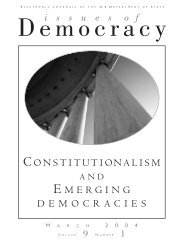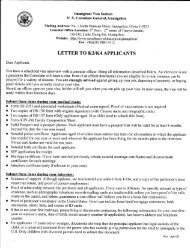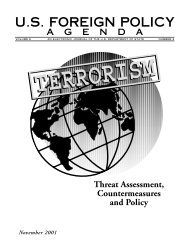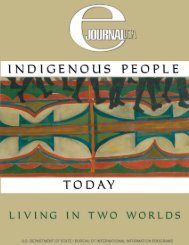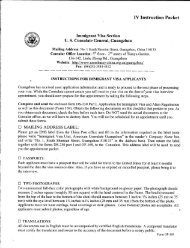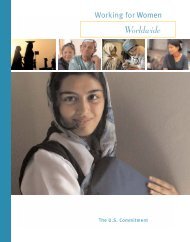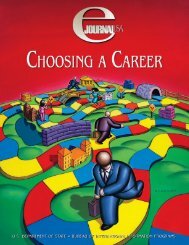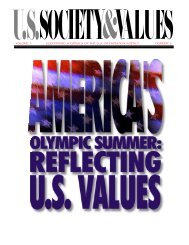s. history us history us history - Embassy of the United States
s. history us history us history - Embassy of the United States
s. history us history us history - Embassy of the United States
- No tags were found...
Create successful ePaper yourself
Turn your PDF publications into a flip-book with our unique Google optimized e-Paper software.
CHAPTER 13: DECADES OF CHANGE: 1960-1980OUTLINE OF U.S. HISTORYKENNEDY AND THECOLD WARPresident Kennedy came into <strong>of</strong>ficepledged to carry on <strong>the</strong> ColdWar vigoro<strong>us</strong>ly, but he also hopedfor accommodation and was reluctantto commit American power.During his first year-and-a-halfin <strong>of</strong>fice, he rejected American interventionafter <strong>the</strong> CIA-guidedCuban exile invasion at <strong>the</strong> Bay <strong>of</strong>Pigs failed, effectively ceded <strong>the</strong>landlocked Sou<strong>the</strong>ast Asian nation<strong>of</strong> Laos to Communist control, andacquiesced in <strong>the</strong> building <strong>of</strong> <strong>the</strong>Berlin Wall. Kennedy’s decisionsreinforced impressions <strong>of</strong> weaknessthat Soviet Premier Nikita Khr<strong>us</strong>hchevhad formed in <strong>the</strong>ir only personalmeeting, a summit meeting atVienna in June 1961.It was against this backdrop thatKennedy faced <strong>the</strong> most serio<strong>us</strong>event <strong>of</strong> <strong>the</strong> Cold War, <strong>the</strong> Cubanmissile crisis.In <strong>the</strong> fall <strong>of</strong> 1962, <strong>the</strong> administrationlearned that <strong>the</strong> Soviet Unionwas secretly installing <strong>of</strong>fensive nuclearmissiles in Cuba. After consideringdifferent options, Kennedydecided on a quarantine to preventSoviet ships from bringing additionalsupplies to Cuba. He demandedpublicly that <strong>the</strong> Soviets remove <strong>the</strong>weapons and warned that an attackfrom that island would bring retaliationagainst <strong>the</strong> USSR. After severaldays <strong>of</strong> tension, during which <strong>the</strong>world was closer than ever beforeto nuclear war, <strong>the</strong> Soviets agreed toremove <strong>the</strong> missiles. Critics chargedthat Kennedy had risked nuclear disasterwhen quiet diplomacy mighthave been effective. But most Americansand much <strong>of</strong> <strong>the</strong> non-Communistworld applauded his decisiveness.The missile crisis made himfor <strong>the</strong> first time <strong>the</strong> acknowledgedleader <strong>of</strong> <strong>the</strong> democratic West.In retrospect, <strong>the</strong> Cuban missilecrisis marked a turning pointin U.S.-Soviet relations. Both sidessaw <strong>the</strong> need to def<strong>us</strong>e tensions thatcould lead to direct military conflict.The following year, <strong>the</strong> <strong>United</strong><strong>States</strong>, <strong>the</strong> Soviet Union, and GreatBritain signed a landmark LimitedTest Ban Treaty prohibiting nuclearweapons tests in <strong>the</strong> atmosphere.Indochina (Vietnam, Laos, Cambodia),a French possession beforeWorld War II, was still ano<strong>the</strong>r ColdWar battlefield. The French effort toreassert colonial control <strong>the</strong>re wasopposed by Ho Chi Minh, a VietnameseCommunist, whose VietMinh movement engaged in a guerrillawar with <strong>the</strong> French army.Both Truman and Eisenhower,eager to maintain French support for<strong>the</strong> policy <strong>of</strong> containment in Europe,provided France with economic aidthat freed resources for <strong>the</strong> strugglein Vietnam. But <strong>the</strong> French suffereda decisive defeat in Dien Bien Phu inMay 1954. At an international conferencein Geneva, Laos and Cambodiawere given <strong>the</strong>ir independence. Vietnamwas divided, with Ho in powerin <strong>the</strong> North and Ngo Dinh Diem, aRoman Catholic anti-Communist ina largely Buddhist population, heading<strong>the</strong> government in <strong>the</strong> South.Elections were to be held two yearslater to unify <strong>the</strong> country. Persuadedthat <strong>the</strong> fall <strong>of</strong> Vietnam could lead to<strong>the</strong> fall <strong>of</strong> Burma, Thailand, and Indonesia,Eisenhower backed Diem’sref<strong>us</strong>al to hold elections in 1956 andeffectively established South Vietnamas an American client state.Kennedy increased assistance,and sent small numbers <strong>of</strong> militaryadvisors, but a new guerrilla strugglebetween North and South continued.Diem’s unpopularity grew and<strong>the</strong> military situation worsened. Inlate 1963, Kennedy secretly assentedto a coup d’etat. To <strong>the</strong> president’ssurprise, Diem and his powerfulbro<strong>the</strong>r-in-law, Ngo Dien Nu,were killed. It was at this uncertainjuncture that Kennedy’s presidencyended three weeks later.THE SPACE PROGRAMDuring Eisenhower’s second term,outer space had become an arena forU.S.-Soviet competition. In 1957,<strong>the</strong> Soviet Union launched Sputnik— an artificial satellite — <strong>the</strong>rebydemonstrating it could build morepowerful rockets than <strong>the</strong> <strong>United</strong><strong>States</strong>. The <strong>United</strong> <strong>States</strong> launchedits first satellite, Explorer I, in 1958.But three months after Kennedybecame president, <strong>the</strong> USSR put<strong>the</strong> first man in orbit. Kennedy respondedby committing <strong>the</strong> <strong>United</strong><strong>States</strong> to land a man on <strong>the</strong> moonand bring him back “before this decadeis out.” With Project Mercuryin 1962, John Glenn became <strong>the</strong> firstU.S. astronaut to orbit <strong>the</strong> Earth.After Kennedy’s death, PresidentLyndon Johnson enth<strong>us</strong>iasticallysupported <strong>the</strong> space program. In<strong>the</strong> mid-1960s, U.S. scientists developed<strong>the</strong> two-person Geminispacecraft. Gemini achieved severalfirsts, including an eight-day missionin Aug<strong>us</strong>t 1965 — <strong>the</strong> longestspace flight at that time — and inNovember 1966, <strong>the</strong> first automaticallycontrolled reentry into <strong>the</strong>Earth’s atmosphere. Gemini also accomplished<strong>the</strong> first manned linkup<strong>of</strong> two spacecraft in flight as well as<strong>the</strong> first U.S. walks in space.The three-person Apollo spacecraftachieved Kennedy’s goal anddemonstrated to <strong>the</strong> world that <strong>the</strong><strong>United</strong> <strong>States</strong> had surpassed Sovietcapabilities in space. On July 20,1969, with hundreds <strong>of</strong> millions <strong>of</strong>television viewers watching around<strong>the</strong> world, Neil Armstrong became<strong>the</strong> first human to walk on <strong>the</strong> surface<strong>of</strong> <strong>the</strong> moon.O<strong>the</strong>r Apollo flights followed, butmany Americans began to question<strong>the</strong> value <strong>of</strong> manned space flight. In<strong>the</strong> early 1970s, as o<strong>the</strong>r prioritiesbecame more pressing, <strong>the</strong> <strong>United</strong><strong>States</strong> scaled down <strong>the</strong> space program.Some Apollo missions werescrapped; only one <strong>of</strong> two proposedSkylab space stations was built.DEATH OF A PRESIDENTJohn Kennedy had gained worldprestige by his management <strong>of</strong> <strong>the</strong>Cuban missile crisis and had wongreat popularity at home. Manybelieved he would win re-election284285



